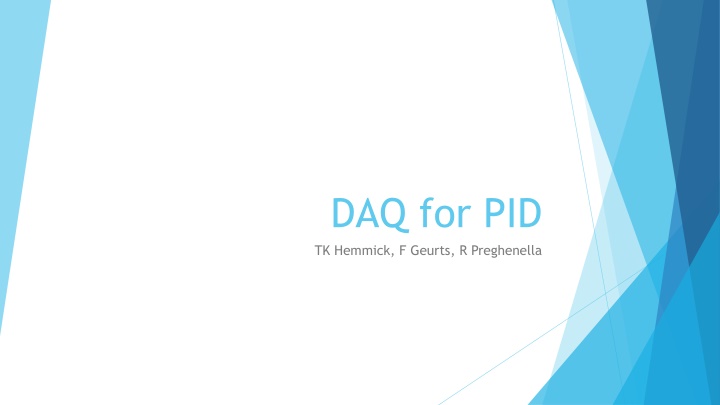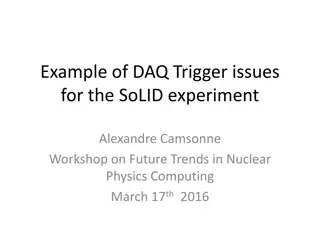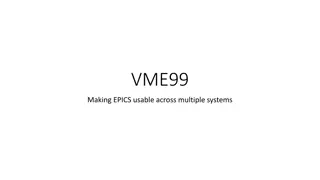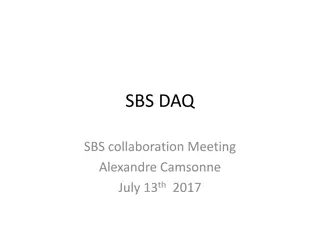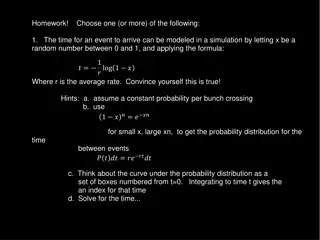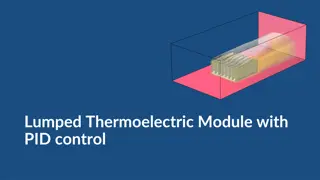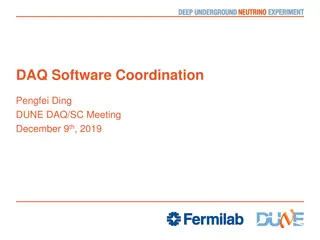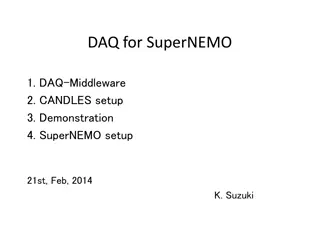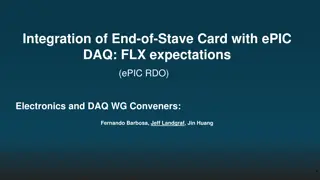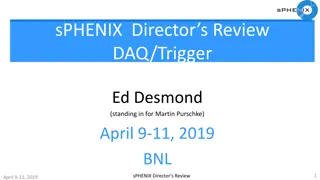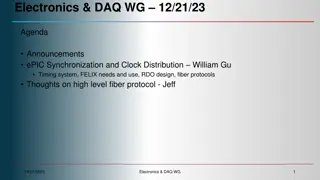DAQ for PID
In the field of particle physics, DAQ (Data Acquisition) for PID (Particle Identification) plays a crucial role in experimental setups. This content discusses the maturing cost estimates, channel counts, and the challenges faced in developing the best available basis for DAQ systems. It touches upon the complexities of technology in flux, the importance of channel count and noise measurements, as well as the integral role of the DAQ group in various experimental proposals. Furthermore, it explores the baseline configuration of different detector components and the alternative implementation strategies being considered to optimize performance. The content also delves into the details of mRICH and DIRC systems, highlighting concerns and advancements in their design and implementation.
Download Presentation

Please find below an Image/Link to download the presentation.
The content on the website is provided AS IS for your information and personal use only. It may not be sold, licensed, or shared on other websites without obtaining consent from the author.If you encounter any issues during the download, it is possible that the publisher has removed the file from their server.
You are allowed to download the files provided on this website for personal or commercial use, subject to the condition that they are used lawfully. All files are the property of their respective owners.
The content on the website is provided AS IS for your information and personal use only. It may not be sold, licensed, or shared on other websites without obtaining consent from the author.
E N D
Presentation Transcript
DAQ for PID TK Hemmick, F Geurts, R Preghenella
Apologies Information Status: Maturing cost estimates Includes channel counts Best available basis for DAQ DAQ Request for Info Highly incomplete Expect(hope) experts online. Moving target I am aware that the DAQ group is treated poorly because: They are vital and formed early Channel count/noise are among the last measurables. PID is the worst in terms of technology in flux True for all EIC proposals. Difficult egg to crack. Costing Exercise = Light at the end of the tunnel? Basis of input for your questions
Reminder of Baseline Configuration Negative direction: Projective mRICH Principle concern(s) Response (trapped light) Material thickness (can we do less material) Barrel DIRC Principle concern(s) Support/Integration Positive direction: dRICH Principle concern(s) Optics (coupled directly to detector location) Costing exercises also available for non-baseline LGAD (Positive, Negative, Barrel) GridPIX (Barrel)
mRICH in Backward Region Cherenkov Photons in DD4HEP Implemented as a pseudo-projective array: Detector envelope ~planar in Zed. Concern: Calorimeter Group concerned about material Not yet evaluated globally . Nonetheless simulations are optimistic Individual modules tilted toward nominal collision point. Advanced stage of implementation in DD4HEP
Requested Alternative Implementation: Monolithic geometry Thinner due to no walls. Support very likely thinner (note: too thick before support!) Optics options: Lens array: Focused but sometimes split and non-circular rings Proximity: How much zed-gap to achieve required performance. Maybe additional alternatives coming?
mRICH Presently Radiation Makes Dark Hits Huge data load High noise ~Same as dRICH SiPM Digitizer Upstairs Robust signals Low data load Low noise Possibly aggregated in situ? LAPPD Digitizer (local) Upstairs All items are clean multiples of 110 (rounded up from DD4HEP multiplicity) mRICH presently imagined with LAPPD readout. Robust signals (can drive oscilloscope directly without electronics!) Can be transported, if you give up on time resolution. NOT noisy. Fiber count: 110 440 Configuration options under consideration which would affect signal count.
DIRC Presently Robust signals Low data load Low noise Possibly aggregated in situ? Multiple of prisms 16, 32, 64 # fibers MCPPMT Digitizer (local) Historically DIRC group has considered MCPPMT style readout. Some field limitation to the operation. SiPM means 1/4 dRICH I am pretty sure that this is the assumption in the costing. If the 3T of ATHENA makes readout change: SiPM readout NOISY Calorimeters measure MANY photons (noise level changes pedestal) RICHes measure single photons (noise irreducible except for coincidence timing cut) Throttled not triggered 100 kHz 1 MHz in each sensor.
dRICH HUGE data load High noise(!) Timing suppression (eventually) Occasional Annealing reduction Aggregation only after timing cut? SiPM Digitizer (local possible) Throttle SiPM readout NOISY RAW: 12000 Gb/sec @ 120 Felix Calorimeters measure MANY photons (noise level changes pedestal) RICHes measure single photons live Window based upon trigger Clock quality ~ 10 psec Pattern in time Pattern Recognition in FPGA Template for Position External Trigger Throttled not triggered is a possible downstream philosophy. Nonetheless HUGE data volume up front and must preserve timing at some level 100 kHz 1 MHz in each sensor. Jeff showed estimates on Monday. Sorry that the convenors failed to give a slot for these slides to be posted.
LGAD Robust signals Low data load Low noise Possibly aggregated in situ? Barrel Negative Positive Costing in wafers Channel counts: ~15M (pixels) and ~8M of strips Not sure the level of aggregation.
GridPIX Readout Up-front digitized (GridPIX all in one) LARGE data load 3000-8000 hits per track Low noise Aggregated in situ Test beam implementations are not 2000 fibers is not as thin as 144 FPGA s Assumed on-detector aggregation 12 logical sectors 12 FPGA/sector 144 fibers heavy data load in each fiber Based upon Bonn test beam experience
